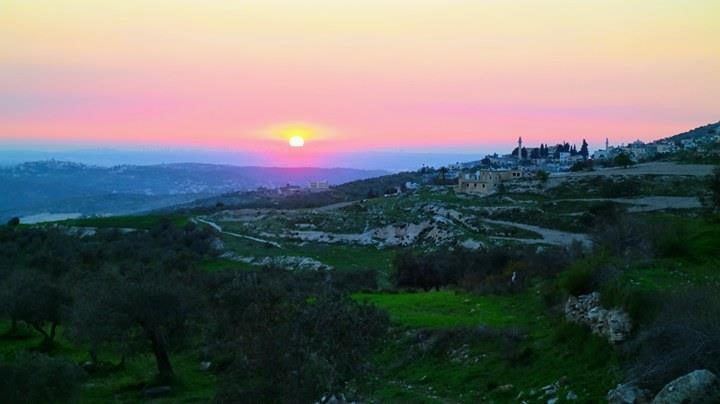【English follows】ヨルダン川西岸随一の都市ヘブロン。ユダヤ教・イスラム教・キリスト教の祖であるアブラハム(イブラヒム)が、ヒッタイト人から買い取り家族の墓所とした「マクペラの洞窟」(ユダヤ教)「イブラヒム・モスク」(イスラム教)が旧市街に在る。カナン人の町として興ったヘブロンはユダヤ人、アラブ・イスラム教徒、十字軍、サラディーン、オスマン帝国と統治者を変え、ある集団が栄えては消え、また共存し、再興するという、兵どもの夢の跡を見るかのような、人間の全ての欲をない交ぜにしたような、めくるめく歴史を辿ってきた。町には、ユダヤ人、ムスリム、キリスト教徒が暮らしていたものの、19世紀末のシオニズム運動の活発化により、ユダヤ人が多く移住してきてからは、衝突が頻繁に起こるようになり、惨劇の舞台となり続けている。現在ではパレスチナ自治政府とイスラエル政府によって管理される2地区に分けられているが、旧市街中心地はパレスチナ人とイスラエル人入植者の住居が混在しており、イスラエル兵の姿を目にすることが多い。(ヘブロンの歴史と現在については、文章末に軽く書いています)
旧市街を歩いていると、30代くらいの父親と、人なれした女の子が路上で刺繍製品を売っていた。そしてふと思い出した。パレスチナに来たばかりの2015年の冬、旧市街の中にある彼らの家を訪れたことを。観光客を家に招き入れ、心づけを生活費の足しにしているようだった。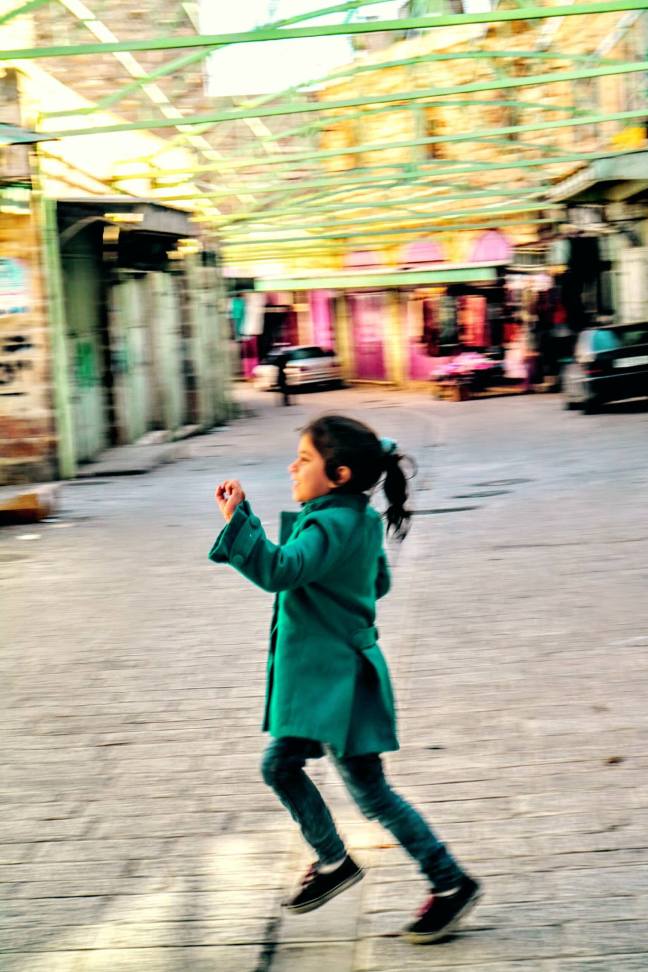
家を訪ね、屋上から見えたのは、周りに広がるイスラエルの国旗が掲げた入植者の家々。私は住宅上に設置された施設で監視するイスラエル兵の視線を感じながら、しばし町を見渡していた。その後、アラブ・コーヒーを飲みながら車座になって話しをしている中で、第二次世界大戦で敵対していた日本とアメリカの現在の関係性について聞かれた。彼の英語力は乏しく、私もほぼアラビア語を解さなかったため、簡単に「戦争は終わった。今は友好関係にある」と言うと、彼は怒り出した。「どうして、町を破壊した敵と友人関係になれるんだ。あり得ないし、理解できない」と。何度か説明を試みたものの、彼の怒りは収まらず、また双方の言語能力に限界があったため、私は議論を辞め、色々と飲み込んだ。そして、今、まさに進行中の出来事の中にいる彼らに、戦争を経て70年以上経つ時代に生きている日本人の私が何を説明しても、助けならないことを感じた。
そんなことを思い出しながら、以前家に訪ねたことがあるということを伝えると、女の子は「あー!覚えている!」と興奮した様子であったが、真偽は不明である。父親の方が疲れているようで、私が商品を買う気がないことに気づいてからは、上の空状態であった。
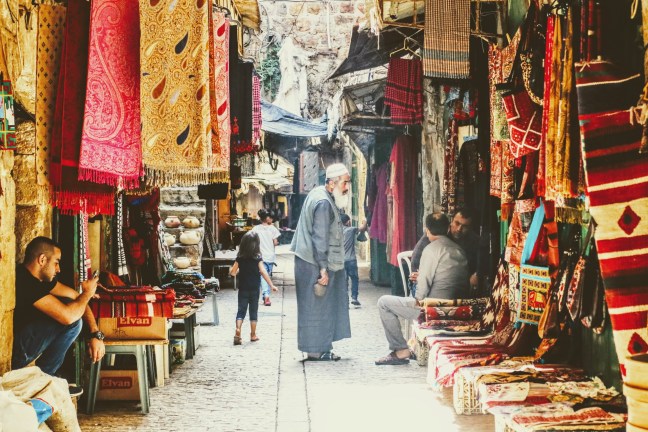
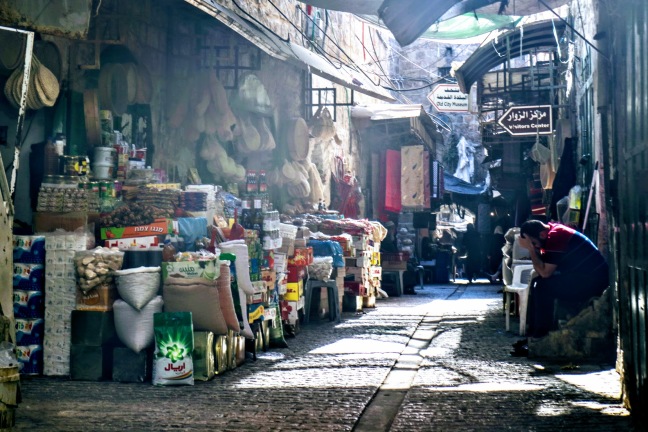
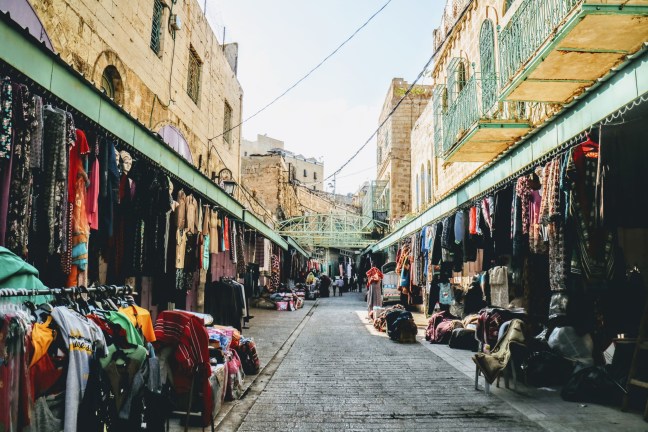
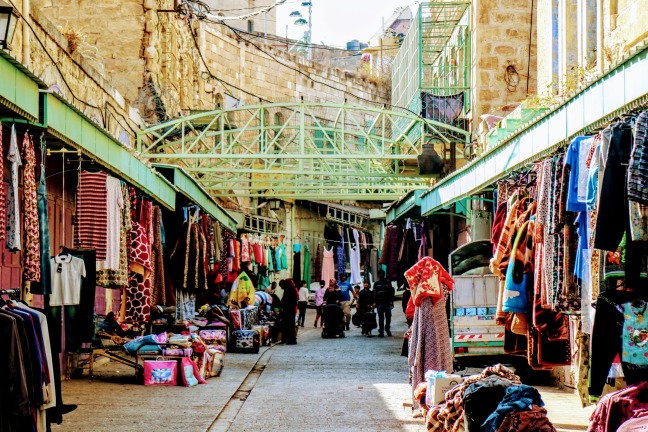
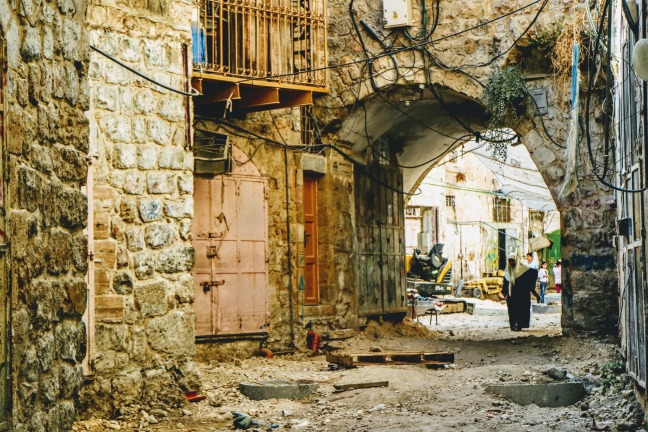
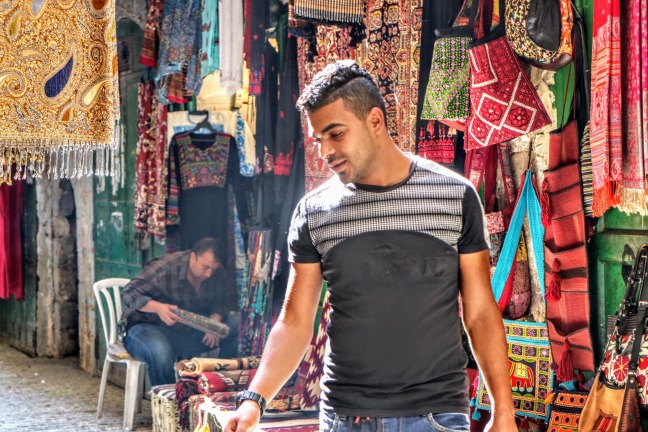
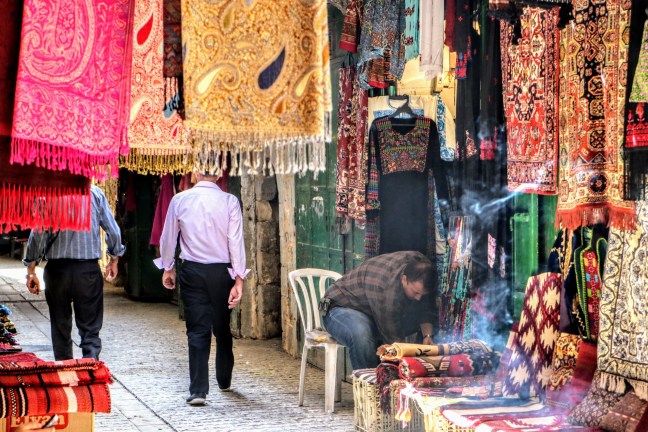
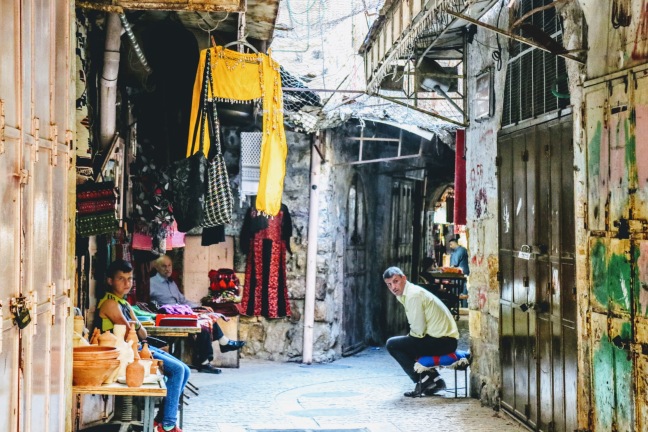
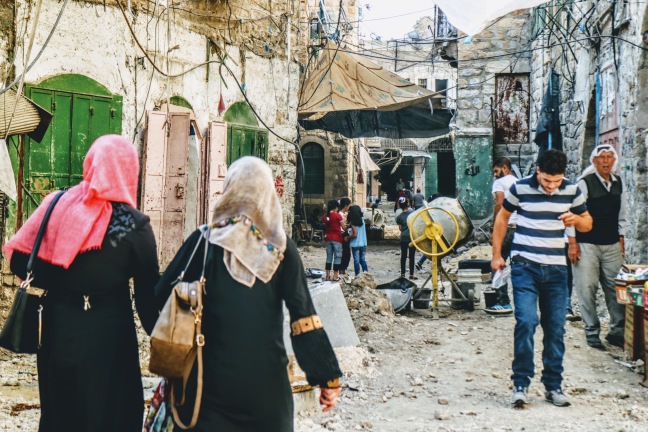
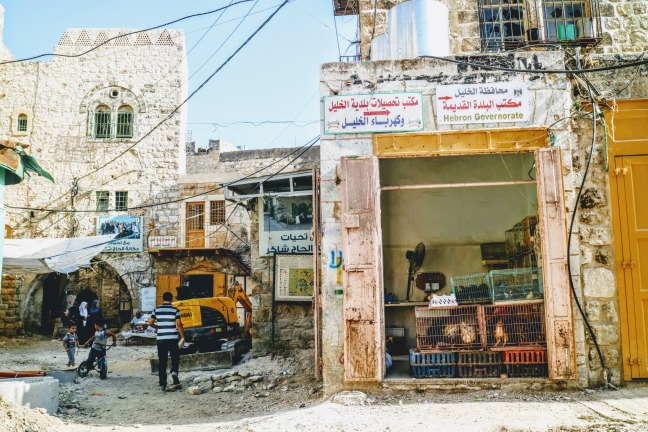
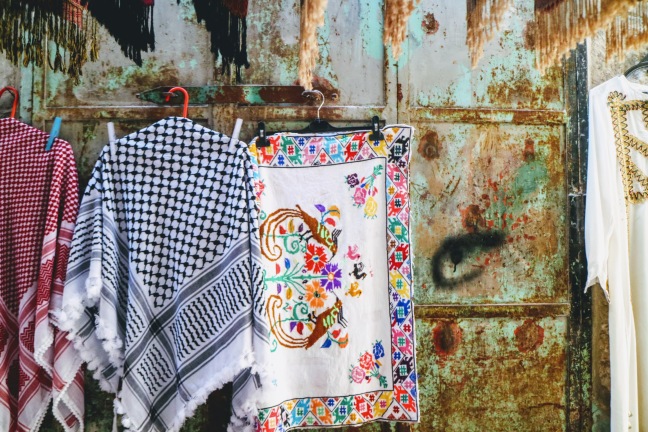
歩を進め、旧市街を通り抜けると、件のイブラヒム・モスクに辿り着く。周辺はイスラエル兵によって管理されており、ゲートを通り、チェックを受けてなければならない。金髪碧眼のアラビア語を話すイスラエル兵が、私の身分証明書をチェックしながらアラビア語で「名前は、、、あ、What is your name」と言い直していたのが、何故か印象に残った。
ゲートを抜けると、道の向こうにはイスラエル兵と入植者によって、物理的に扉が溶接され、文字通り扉が固く閉ざされている店が並んでいる。もうそこには、13世紀以来栄えてきたというスークの面影はなく、数軒の店が営業しているだけであり、遠目に見ても閑古鳥が鳴いているのは確かである。店先にいた24歳の若者ムハンマドと言葉を交わした。もちろん他に客などいない。先祖代々この地で商売をし、彼自身は5年ほど前に店を開いたそうだ。「昔は1800軒もの店が軒を並べていたんだよ」と言う。
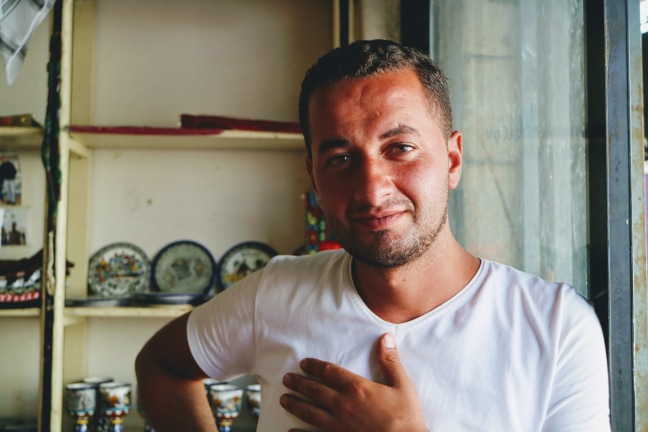
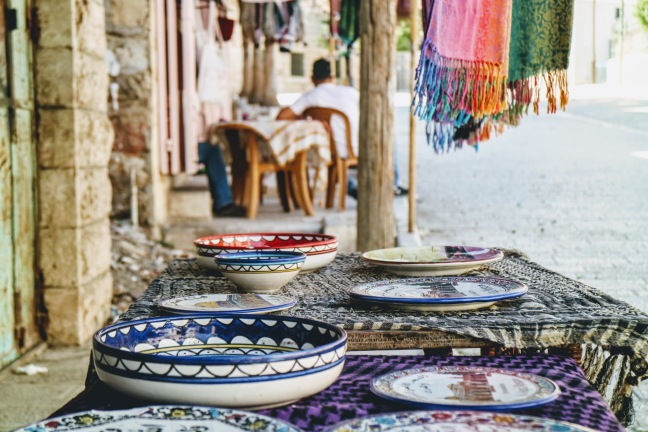
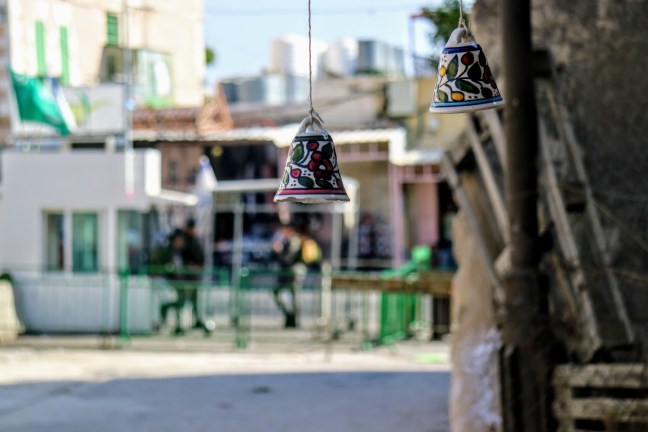

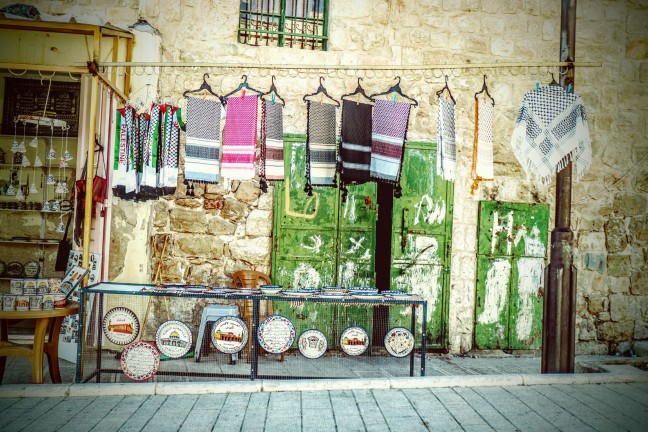
日本人に貰ったという「大入」の壁掛けが入り口付近に飾られていた。人当たりが良く、雰囲気の柔らかい彼に好感を持ったであろう日本人が、彼の成功を願って、プレゼントしたであろうことは、容易に想像できる。「大入」には、商売繁盛という意味が込められているという説明をしたものの、彼らが置かれている状況が改善され、観光客が増える兆しが、私には全く見えないため、説明した後に、虚しい気持ちになり、でかでかと赤地に書かれた「大入」の文字に罪深さすら覚えた。店内に陳列されたヘブライ語の陶器を見て「イスラエル人の観光客がくるの?」と聞くと、「海外からユダヤ人が来るんだよ」と教えてくれた。
ムハンマドの店の先には、入植地との境界、むしろ入植地にかかった形で経営する店舗が2,3軒あった。境界から確実に入植地寄りにある店を背に通りに目を向けるとと、私の左側にある閑散としたスークを歩いてくる若い入植者2人が、私の正面にゲートを設けているイスラエル兵の脇を通り、私の右側に位置する入植地地区に入っていった。私の後ろには、そのような光景を毎分目にしているであろうパレスチナ人の店主がコーヒーを飲みながら、欧米系の2人観光客に彼らの日々の状況を話している。一周回ってシュールな光景であった。
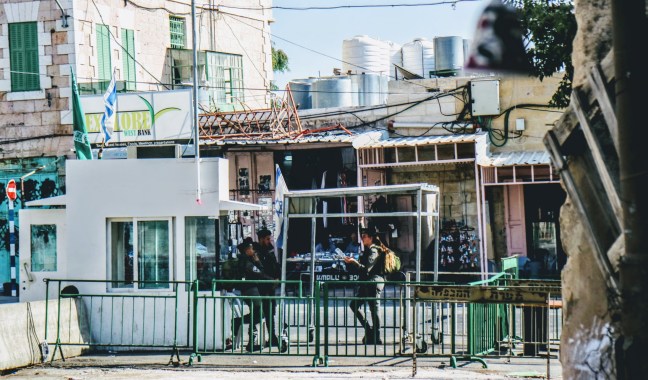
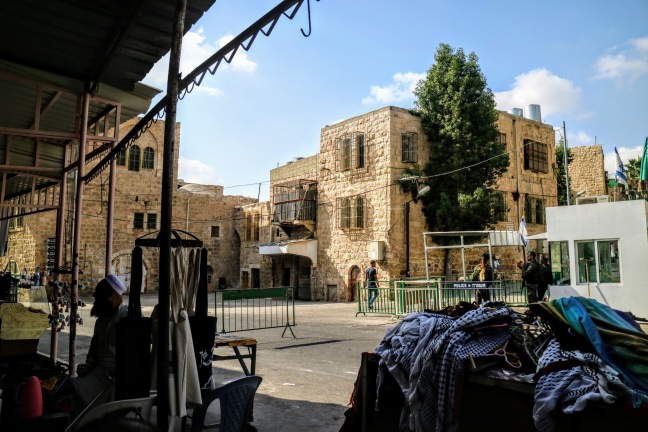
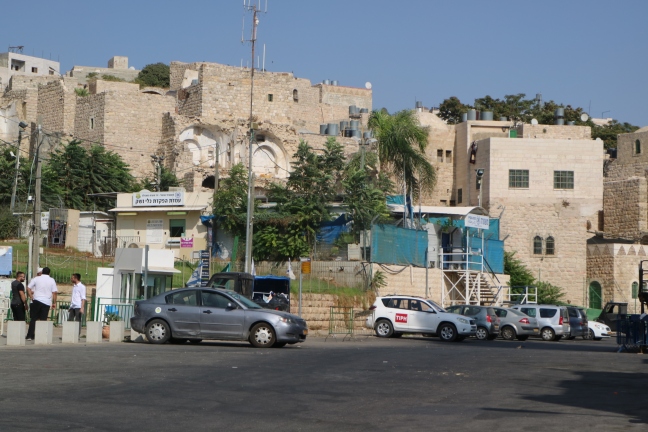

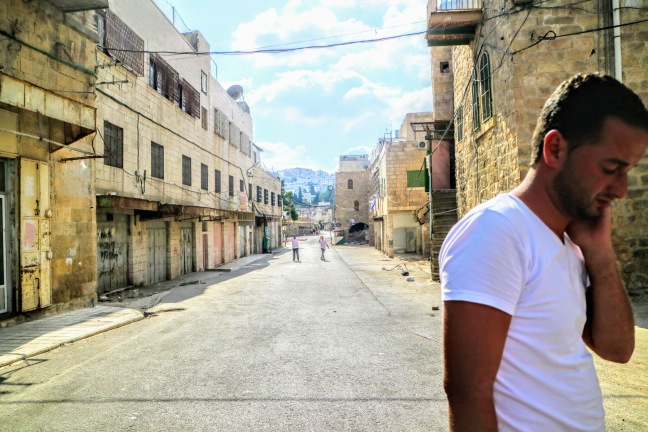

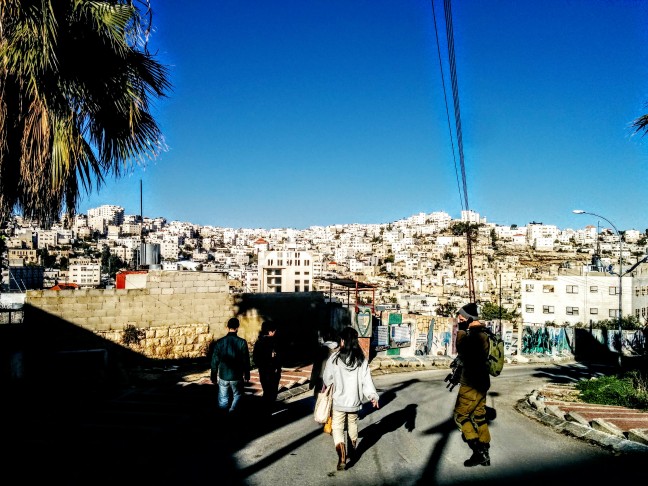
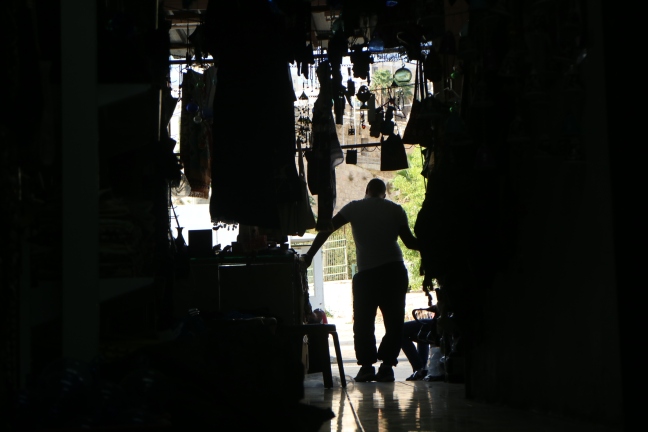
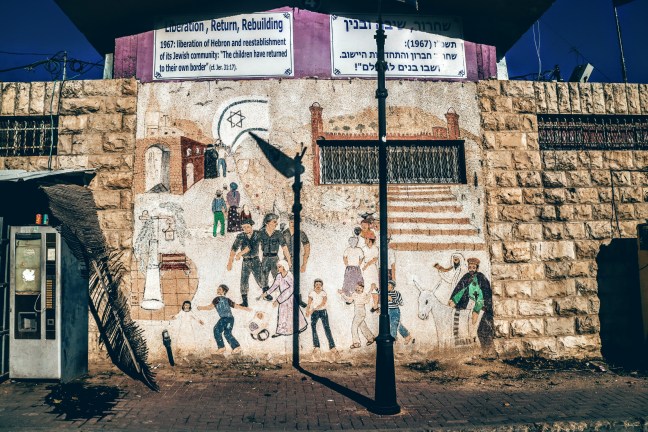
店から出るとムハンマドがいた。「どうしたの?待っててくれたの?」と聞くと、「君たちがイスラエル兵の嫌がらせに合うかと思って。特に彼女」と私と一緒にいたヒジャーブ女子であるパレスチナ人の友人を指して言った。
私たちは、ムハンマドにさよならを言い、またイスラエル兵の管理するゲートに向かった。
すると、先ほどの金髪碧眼の兵士が、休憩中なのか、寛いだ様子で外の椅子に座り、こちらに笑顔を向けて、アラビア語で何か言葉を発した。ただ、その笑顔と言葉は私に向けられたものではなく、私の後ろにいたムハンマドと彼の友人に向けられたものだった。ムハンマドと彼の友人、そしてこの場所に頻繁に配置されているのであろう当該イスラエル兵士は、アラビア語で冗談を言い合っているようで、傍目から見ると、道端で若者同士が普通に会話をしているように見えた。一方は、銃を抱え、ヘルメットをかぶった青年兵士ではあったが。
そして、兵士のすぐ後ろの、鉄格子のゲートの向こうに目を向けると、パレスチナ人女性が通り方が分からないのか、立ち往生しているのが見えた。
夏の終わりの晴れた日の午後、双方の聖地となっているアブラハムの墓がある洞窟/モスクの前で、所在なさげにしているモスク前のイスラエル兵たちの前を笑顔で歩きながら、ゲートの管理をするイスラエル兵とアラビア語で楽しそうに言葉を交わすパレスチナ人の青年ら。その鉄格子のゲートの向こうではパレスチナ人女性がオロオロしている。このような、イスラエル人、パレスチナ人が混在する現場に出くわすと、希望と現実、悲しみと憤り、諦めを通り越したシュールな気分にさせられる。
(歴史/現在)
旧約聖書には、町(ヘブロン/キリアテ・アルバ)は「エジプトの町Zoanができる7年前」(紀元前1720年頃)に形づくられたと記述されている。ユダヤ教、イスラム教、キリスト教の祖であるアブラハムが紀元前1650年頃、現在の旧市街にある洞窟周辺の土地を、ヒッタイト人(ヘト人)から買い取り、自らを含む一族の墓としたとされ、洞窟は「マクペラの洞窟」(ユダヤ教徒)と呼ばれている。このためユダヤ教信者の中では「ユダヤ人が初めに購入した土地」と認識し、土地の権利を主張する人もいる。また、コーランにも「イブラヒム」がこの土地を購入した話は記載されており、洞窟の上に建てられたモスクは「イブラヒム・モスク」(イスラム教徒)と呼ばれ、ユダヤ教徒、イスラム教徒双方にとって重要な聖地となっている。
紀元前1000年頃、イスラエルの最初の王であったサウルの後を継いだダビデはヘブロンで油を注がれ、ユダ部族の王となった。ユダヤ人の国はローマ帝国に滅ぼされるまで続き、その後、ヘブロンの町はアラブ・イスラム教徒、十字軍、アイユーブ朝、マムルーク朝、オスマン帝国と欲す欲せずに関わらず次々と支配者を変え、その過程の中で「マクペラの洞窟」の上に建設されたユダヤの王、ヘロデの城は教会からモスク、また逆にモスクから教会に、そしてまたモスクへと時代により形を変えている。時代の変遷の中で、ヘブロンの町は、イスラム教徒が大半を占めるようになってはいたが、ユダヤ人のコミュニティーは消滅、再建を繰り返し、細々と生き延び続けてきたようだ。
1538年のオスマン帝国時代にヘブロンの町にはイスラム教徒749世帯、キリスト教徒7世帯、ユダヤ教徒20世帯が、1922年のイギリス統治下ではイスラム教徒16074人、キリスト教徒73人、ユダヤ教徒430人がいたとされいる(出典:1922Census of Palestine)。
シオニズムが活発化と共に、ユダヤ人の入植がはじまるとユダヤ人とパレスチナ人との間に暴動がおこるようになり、パレスチナ人の暴動により1929年、67人のユダヤ人が殺され、その他のユダヤ人も町から追放された形となり、ユダヤ人のコミュニティーは消滅した。しかし1967年の6日戦争(第3次中東戦争)の後、1929年にユダヤ人の元住民が戻り始め、郊外にキリヤト・アルバと名付けられた入植地を建設、以来ユダヤ人の入植が続く。ちなみに旧約聖書でヨシュア記でヘブロンはキリアテ・アルバとも記載されている。1980年には6人の入植者がパレスチナ人に銃撃され、1994年のユダヤ教過激派の医師によるマクペラの洞窟(イブラヒム・モスク)で起きた銃乱射事件で29人のパレスチナ人が死亡するなど、双方の虐殺が繰り返されてきた。
1997年のヘブロン合意後、ヘブロンはパレスチナ自治政府が管理するH1(市の80%)と、イスラエルの支配下にあるH2(旧市街一部を含む市の20%)に分けられているが、旧市街中心地はパレスチナ人と入植者の住まいが混在しており、旧市街の中心部には650人ほどの入植者が、そして1200ー1500人のイスラエル兵士と警察官が常駐している。旧市街の住宅の2階部分に居住する入植者が、1階のパレスチナ住民に向かってごみを投げるため、住民がごみが落ちてくるのを防ぐために張っている網にごみが沢山かかっている光景は有名である。
Hebron located in the southern part of West Bank has a rich history that had flourished as a centre of trade. In addition, the tomb of Abraham in the old town raises its importance as the sacred place for Jews, Muslims and Christians, and it has become the scene of many tragic events in the past and present.
Since the town was founded by Cananni, Hebron has been ruled by various powers, such as Jews, Arab-Muslims, Crusaders and the Ottoman empire. At the same time, the Jewish Herod’s castle which was built upon the grave of Abraham (Cave of Machpelah: Jews, Ibrahim Mosque: Muslim) has been transformed sometimes into Churches and Mosques. Throughout history Jews, Muslims and Christians have maintained their life in Hebron. However, since Jewish population increased due to the Zionism movement back in 19th century, the conflict between Jews and Muslims occurs frequently. The atrocities lived by both sides have divided Hebron into 2 sections (One under the Palestinian Authority and the other under the Israel government). The centre of the old town is mixed with Palestinian residences and Israeli Settlements, therefore many Israeli soldiers and Police officers have been stationing there. You might see some pictures that Israeli soldier point a gun at Palestinian children and also the rubbish stuck on the street roof net thrown by Israeli settlers who live on the 2nd floor to Palestinian residents who live on the ground floor.
When I walked in the deserted old town, I found a father and daughter who sell handmade embroidery on the street. Suddenly I remembered the day I visited their house in the first winter of 2015 in Palestine. On that day, I went up to the roof. It was obvious that their house was surrounded by Israeli settlers houses who raise the Israeli flags to show their existence. I looked over the old town while I felt the stare from Israeli soldiers who are stationed on the settler’s roof.
At some point during the visit, the father asked me about the current relationship between Japan and the U.S. who fought during WW2. I tried to explain simply because both didn’t have enough language abilities to communicate in English or Arabic. So I said: ‘‘The war ended. Now we have friendly relationship’’. However, he showed his extreme frustration and shouted: ‘‘How can you become friends? You fought each other hard. I can’t understand’’. Then I realized that saying such things to him while the conflict is ongoing doesn’t help him to understand because I’ve grown up in Japan where the war ended 70 years ago.
Those memories came to my mind when I saw him on the street, then I told him that I visited his house. The girl said that she remembers that. However, it seems that father’s mind was blocked after he noticed that I wasn’t going to buy the goods which he was selling.
We reached the gate which is installed in front of the Ibrahim Mosque (Cave of Machpelah for Jews). The area is surrounded by Israeli soldiers, and can’t enter the place without answering the questions from soldiers. The soldier who had blue eyes and blond hair asked me some questions, but firstly in Arabic. ” Shu ismik? Oh, what is your name”. It seems that Arabic occupied some part of his brain due to his daily communication with the Palestinians.
After we passed the iron gate, there was the market which bustled with many people since 13th century, however, most of the shops’ doors were physically welded together by Israeli soldiers and settlers.
We exchanged some words with shop owner Muhammad. This young guy opened his shop 5 years ago like his ancestors did in the past. He told us: ”In the past, 1,800 shops made a cheerful and brilliant atmosphere.Things have changed completely”. The Hebrew written potteries were displayed same like I saw in the pottery factory in Hebron which is for Jewish customers from abroad. I found the red tapestry with the Japanese language, which means praying for a thriving business. I can easily imagine a Japanese gave this to him due to his humble and friendly attitude. I explained the meaning behind this tapestry, however, I felt vanity because I couldn’t see any sign of a better situation in Hebron. I even felt sinful for the big words written upon the tapestry.
We went to another souvenir shop located just between the Settlement and a Palestinian area, but it feels to be more located in the Settlement area. In the front of the shop, two young Israeli settlers walked in front of me towards the gate to enter the settlement. Behind me there was a Palestinian Hajji (Middle age guy ) who witnesses that view every day while serving his Arab coffee to the Western tourists and inform them about his daily circumstances. It was somehow a surrealistic view!
When we were leaving the shop, Muhammad the owner of the other shop was waiting for us at the front of the shop. I asked him: ‘‘Were you waiting for us? ’’. He said: ‘‘You will be Ok but your Palestinian friend wearing Hijab could be harassed by the soldiers. I am just concerned’’.
We appreciated his concern and said goodbye to him and walked toward the iron gate again. The soldier with the blue eye who checked me at the gate sat on a chair near the gate during his break. He gave a charming smile and said something in Arabic, not to me, but to Muhammad and his friend walking behind us. All of them seem to know each other ( Israeli soldiers and local Palestinians).Both sides share jokes in Arabic and smiles. As an outsider, it seems that those young guys enjoyed their conversations, except one guy, the one carrying the gun.
Behind the soldiers, I overlooked to a Palestinian woman stuck behind the iron gate afraid whether she could pass the gate or not.
At the end of the summer day, I had some strange feelings and emotions running through my body outside the boundaries of having hope, facing reality, hopelessness, sadness, frustration and abandonment when I witness the life scene of Palestinians and Israelis.
